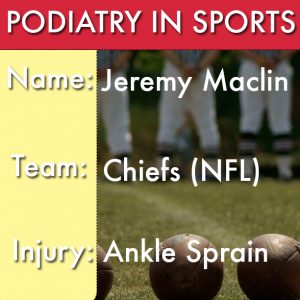The Kansas City Chiefs announced Sunday that an MRI revealed wide receiver Jeremy Maclin suffered a sprained right ankle in Saturday’s wild-card victory over the Houston Texans at NRG Stadium.
The 27-year-old wideout was taken to the locker room on a cart after following a reception in the third quarter after reeling in three catches for 29 yards.
ESPN’s Adam Schefter first reported Sunday that Maclin suffered only a high ankle sprain, after an MRI result indicated no ACL tear.
The favored target of quarterback Alex Smith, Maclin had 87 receptions for 1,088 yards and eight touchdowns during the regular season. After the game, he took to Twitter to thank fans for their support, saying, “Appreciate the love support and prayers!”
In many ways, Maclin dodged a bullet by avoiding what would have been his third surgery to repair damaged ligaments in his knees. That being said, high ankle sprains can also be very difficult to overcome.
At Delray Beach Podiatry, Dr. Ian S. Goldbaum, a podiatric physician and surgeon with over 30 years of experience, has studied the workings of the ankle throughout his lengthy tenure in medicine and believes that Maclin should be sidelined for the upcoming week and will most certainly be very limited if he does indeed play.
According to Dr. Goldbaum, when a high ankle sprain occurs there is the potential for several structures to be damaged. These include the syndesmotic ligaments that connect the tibia to the fibula, as well as a tissue known as the interosseous membrane.
High ankle sprains are described as high because they are located above the ankle. They are caused by an outward twisting of the foot and ankle and comprise approximately 15% of all ankle sprains.
The severity of this injury often depends on how many of these structures are damaged and recovery times can vary from a few weeks to a few months.
High ankle sprains are graded on a scale of 1–3 based on their severity:
Grade 1 (Mild): In mild cases, the ligaments are somewhat stretched, resulting in joint stiffness, muscle weakness or tightness with reduced balance and joint awareness. It takes approximately six weeks for ligaments to heal from a Grade 1 sprain.
Grade 2 (Moderate): In moderate cases, there is significant ligament stretching and sometimes partial tearing. It is far more painful than a mild sprain and can make it difficult to walk. A recovery time of 6 to 12 weeks can be expected.
Grade 3 (Severe): In severe cases, the ligament can completely rupture. There is severe swelling, extensive bruising, and immense pain felt with a Grade 3 sprain. In most cases, a patient will need a screw inserted into their ankle to stabilize the area while it heals. A recovery time of 3 to 6 months can be expected.
It’s clear that even if Maclin did only sustain a Grade 1 sprain that he shouldn’t be counted on to be as explosive as he has been if he attempts to play through the pain. High ankle sprains are often multiple week injuries, but sometimes a player returns more quickly than that. In 2014, Chiefs running back Jamal Charles missed one week with a high ankle sprain before making a triumphant return in a 41-14 victory over the New England Patriots in his first game back.
The Chiefs, who extended their NFL-best winning streak to 11 games over the weekend, will face the Patriots on Saturday.
—
Follow Delray Beach Podiatry on Twitter @Delray_Podiatry
The content on this website is for informational purposes only. Do not rely or act upon information from www.DelrayBeachPodiatry.com without seeking professional medical advice. If you live in South Florida and would like a consultation with Dr. Ian Goldbaum, a podiatric physician and surgeon with over 30 years of experience, please see our contact information below:
BOCA/DELRAY
16244 S. Military Trail #290, Delray Beach, FL 33445
561-499-0033
BOYNTON BEACH
8198 Jog Road #100, Boynton Beach, FL 33472
561-499-0033


No responses yet